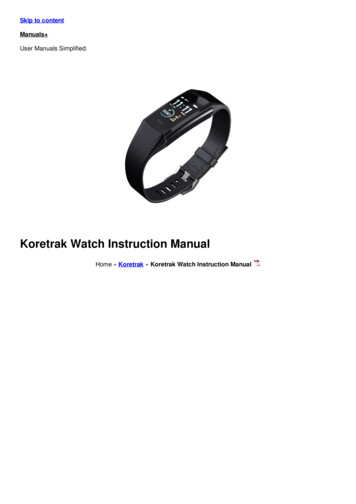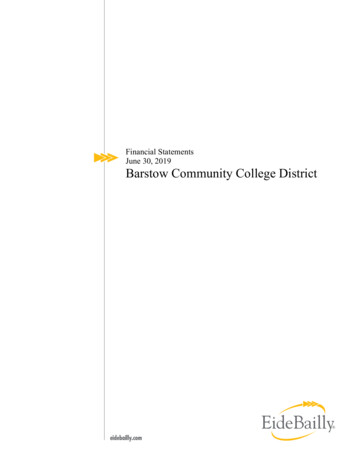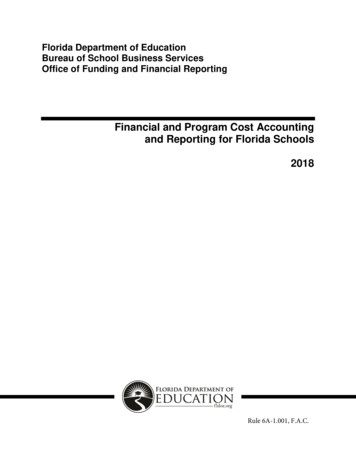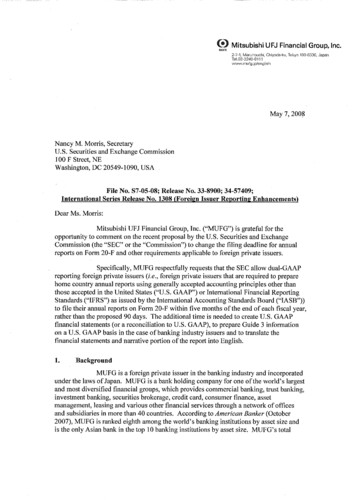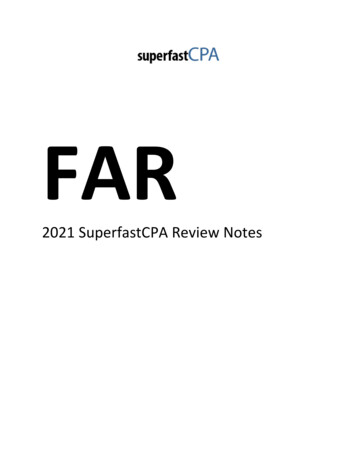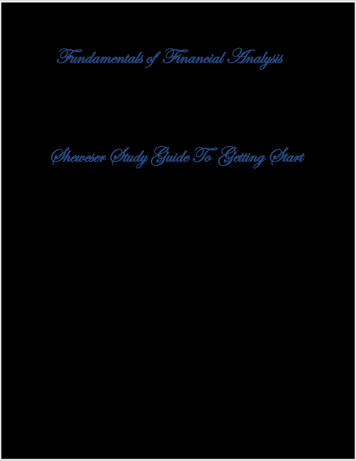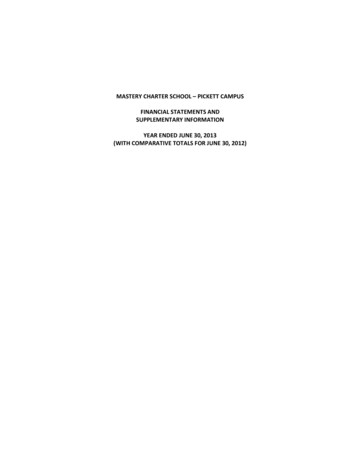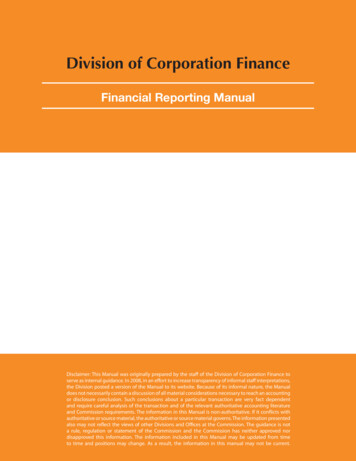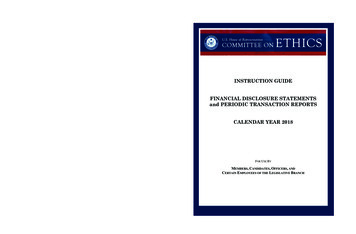
Transcription
Calendar Year 2018: Instruction Guide for Completing Financial Disclosure Statements and Periodic Transaction Reports35-520 cov.pdf 1INSTRUCTION GUIDEFINANCIAL DISCLOSURE STATEMENTSand PERIODIC TRANSACTION REPORTSCALENDAR YEAR 2018FOR USE BYMEMBERS, CANDIDATES, OFFICERS, ANDCERTAIN EMPLOYEES OF THE LEGISLATIVE BRANCH3/18/19 5:23 PM
CONTENTS————GENERAL INFORMATIONIntroduction . 1Statutory Background . 1Electronic Filing System and Forms . 1Getting Assistance . 1Who Must File and When . 2Annual FD Statement Filers . 2Candidates . 3New Officers and Employees . 5Termination Filers. 5Periodic Transaction Report Filers . 5Filing Deadlines for PTRs . 5Reporting Period . 6Reporting of Spouse and Dependent Child Financial Information . 6Timeliness of Filing . 7Extensions . 7Late Filing Fee . 7Where to File and Number of Copies. 8Committee Review . 8Failure to File or Falsifying Disclosure Statements . 9Public Access . 9Unlawful Use. 9Forms Not Net Worth Statements . 10SPECIFIC REPORTING INSTRUCTIONSFD Statements . 11Tools to Complete the Form . 11Signature and Certification . 11Preliminary Information Page . 11IPO Attestation and Disclosure Exemption Questions . 12Initial Public Offering Attestation . 12Trust Exemption . 12Spouse and Dependent Disclosure Exemption .13Schedule A – Assets and “Unearned" Income . 14Explanation . 14Reportable Assets . 14Reportable Unearned Income . 14Valuation of Assets . 14Reporting Particular Assets . 15Real Estate. 15Farms . 15Reporting of Investment Accounts . 15Brokerage Accounts and Accounts with an Investment Advisor .16Retirement Accounts . 16Defined-Benefit Pensions . 16529 College Savings Accounts . 16Reporting of Investment Funds. 17-i-35-520 text CX.pdf 13/25/19 9:22 AM
Mutual Funds, Exchange Traded Funds (ETFs), and Publicly-TradedReal Estate Investment Trusts (REITs) . 18Hedge Funds, Private Equity Funds, Privately-Traded REITs, and OtherPrivate Funds . 18Cryptocurrencies . 19Corporate Securities . 19Futures and Options . 19Government Securities and Agency Debt .19Asset-Backed Securities . 20Annuities . 20Insurance Policies . 20Bank Accounts . 21Ownership Interests in Privately-Held Partnerships, Corporations, andOther Business Entities . 21S Corporations . 22Debts Owed to the Filer . 22Trusts . 22Investment Clubs . 23Collectibles Held as Investments . 23Intellectual Property Rights . 24Exclusions. 24Asset Comparison on Successive Filings . 24Column-by-Column Instructions for Schedule A .24Note on Brokerage Statements . 26Schedule B – Transactions . 27Explanation . 27Column-by-Column Instructions for Schedule B .28Exclusions . 29Schedule C – Earned Income . 29Explanation . 29Reportable Earned Income . 30Exclusions. 30Special Considerations . 30Income Cap . 30Fiduciary Restrictions . 31Schedule D – Liabilities . 31Explanation . 31Reportable Debts . 31Types of Debt That Must Be Disclosed . 31Exclusions . 32Column-by-Column Instructions for Schedule D .33Schedule E – Positions . 33Explanation . 33Reportable Positions . 33Exclusions. 34Schedule F – Agreements . 34Explanation . 34Reportable Agreements . 34Exclusions. 34Schedule G – Gifts . 34Explanation . 34Reportable Gifts . 35Exclusions . 35-ii-35-520 text CX.pdf 23/25/19 9:22 AM
Schedule H – Travel Payments and Reimbursements . 36Explanation . 36Reportable Trips . 36Exclusions . 37Column-by-Column Instructions for Schedule H . 37Schedule I – Payments Made to Charity in Lieu of Honoraria . 37Explanation . 37How to Complete Schedule I . 38Special Requirement for Payments from Federal Lobbyists or Foreign Agents . 39Exclusions. 39Schedule J – Compensation in Excess of 5,000 Paid by One Source . 39Explanation . 39Exclusions. 39Before Filing . 40Periodic Transaction Reports. 41Transactions Required to be Reported . 41Exclusions . 42Signature and Certification . 42Preliminary Information . 43Column-by-Column Instructions for a PTR. 43Waivers and Exclusions from the PTR Requirement . 43Disclosure Requirements for Selected Assets Chart. 45SAMPLE COMPLETED DISCLOSURE FORMSFORM A (For Use by Annual and Termination Filers) . SF–1FORM B (For Use by New Members, Candidates, and New Employees). SF–15Periodic Transaction Report . SF–25APPENDICESAppendix AA. Ethics in Government Act, Title I. A–1Sec. 101. Persons Required To File . A–1Sec. 102. Contents of Reports . A–3Sec. 103. Filing of Reports . A–9Sec. 104. Failure To File or Filing False Reports . A–11Sec. 105. Custody of and Public Access to Reports . A–12Sec. 106. Review of Reports . A–14Sec. 107. Confidential Reports and Other Additional Requirements . A–15Sec. 108. Authority of Comptroller General. A–15Sec. 109. Definitions . A–15Sec. 110. Notice of Actions Taken To Comply with Ethics Agreements . A–17Sec. 111. Administration of Provisions . A–17STOCK Act, Public Law 112-105 . A–17Public Law 113-7. A–22Public Law 112-173. A–23Public Law 112-178. A–23Public Law 112-207. A–24-iii-2-DRAFT CY 2018 Table of Contents CX2.pdf 13/29/19 8:54 AM
Appendix BB. Interpretive Ruling No. 1, Designation of principal assistants byMembers of the House of Representatives for purposes of filing aFinancial Disclosure Statement . B–1Appendix CC. Selected House Rules . C–1House Rule XXV, clause 5 (the Gift Rule). C–1House Rule XXIII, clause 15 (the Private Plane Rule) . C–8Appendix DD. Policy Regarding Amendments to Financial DisclosureStatements—Committee letter of April 23, 1986 . D–1Appendix EE. Notice to Clerk of the House of Withdrawal of Candidacy or ofNot Yet Raising or Spending 5,000 on Campaign . E–1Appendix FF. New Employee FD Filing Exemption Form .F–1Appendix GG. Terminated Employee FD Filing Exemption Form G–1-iv-35-520 text CX.pdf 43/25/19 9:22 AM
GENERAL INFORMATIONIMPORTANTPTRs. In addition, it should reduce some of themost common mistakes made by filers because itleads the filer through the process by asking forthe required information. Filing information willneed to be entered into the online filing system thefirst time a filer uses the online filing system. Thesystem then will retain this information so that itmay be retrieved by the filer for future filings. Afiler can also grant access to the online filingsystem to one or more third parties to help themprepare their filing, including a spouse,accountant, or attorney. If you experience anydifficulties with the online filing system, pleasecall the Office of the Clerk at (202) 226-5200.If you believe you have received a notice fromthe Clerk of the House informing you that youare required to file an FD Statement or PTRsin error, DO NOT DISREGARD THENOTICE. Please contact the Committee immediately, as only the Committee can relieve youof your filing obligation.INTRODUCTIONStatutory BackgroundGetting AssistanceThe following instructions provide a detailedexplanation of the disclosure requirements. Thisguide also contains a sample completed FDStatement and PTR for your referenceimmediately following the instructionsbeginning at page SF-1. Filers are encouragedto carefully read these instructions and refer tothe sample form for examples of the correct way todisclose the most common types of entries. Anyfiler who has questions concerning the reportingrequirements or how to fill out the FD Statementor PTR should call the Committee at (202) 2257103.Pursuant to its authority under 5 U.S.C.app. § 106(b), the Committee has delegated to theCongressional Budget Office, Library of Congress,Architect of the Capitol, Government PublishingOffice, and Capitol Police the responsibility ofreviewing and certifying FD Statements andPTRs, and issuing extensions of time for filing, fortheir own employees. Employees of those agenciesshould contact their respective general counsel’soffice with any questions about their financialdisclosure obligations.It is the Committee’s opinion that any case inwhich a filer believes there is an ambiguity in thereporting requirements should be resolved in favorof disclosure or the filer should request an advisoryopinion from the Committee.Those who would like further informationabout standards of conduct that apply in theHouse may obtain the House Ethics Manual andadvisory memoranda by contacting the Committeeor by visiting the Committee’s website athttps://www.ethics.house.gov.Copies of theCommittee’s Rules are also available on thewebsite.Title I of the Ethics in Government Act of1978, as amended (5 U.S.C. app. §§ 101-111)(EIGA) requires Members, officers, certain employees of the U.S. House of Representatives andrelated offices, and candidates for the House ofRepresentatives to file Financial Disclosure Statements (FD Statements or Statements) with theClerk of the House of Representatives. In addition, the Stop Trading on Congressional KnowledgeAct of 2012 (STOCK Act) amended the EIGA to adda requirement for Members, officers, and certainemployees of the House to report certain securitiestransactions over 1,000 within 30 days of notice ofthe transaction, but in no case later than 45 daysafter the transaction. These STOCK Act filings areknown as Periodic Transaction Reports (PTRs). Inaddition, House Rule 26 provides that Title I of theEIGA shall be deemed to be a rule of the Housewith regard to House Members, officers, and employees. The Committee on Ethics (Committee)administers the EIGA for the House.Online Filing System and FormsThere are two ways to complete both an FDStatement and a PTR: (1) by using the onlinefiling system, or (2) by hand, using a pre-printedform.The online filing system can beaccessed by visiting https://fd.house.gov.Copies of the paper forms can be obtained ics.house.gov and clicking on the“Financial Disclosure” tab.The Committee strongly encourages allfilers to use the online filing system forcompleting both FD Statements and PTRs.Utilizing the online filing system can significantlyincrease the accuracy of your FD Statements and-1-35-520 text CX.pdf 53/25/19 9:34 AM
of the annual senior staff rate, that employee willbe required to file an FD Statement. For 2018, themonthly senior staff rate was 10,512 (Themonthly rate for 2019 is 10,512). Thus, it ispossible for an employee to be required to file anFD Statement because the employee received ayear-end bonus paid in November and December,even though the employee’s total salary for theyear was less than the senior staff rate annualamount.Principal Assistants: Every Member officemust have at least one employee who files anannual FD Statement. Most offices will have atleast one employee who is paid at or above thesenior staff rate (see preceding subsection) andtherefore is required to file an FD Statement. If aMember does not have an employee paid at orabove the senior staff rate, the Member mustdesignate at least one current employee as aprincipal assistant to file an FD Statement. Todesignate a principal assistant, a letter thatidentifies the designee and is signed by theMember must be transmitted to the Clerk of theHouse. A form for this purpose is available on theClerk’s website, www.clerk.house.gov, under the“Public Disclosure” tab. The employing officeshould also immediately notify any employee upontheir designation as a principal assistant.Except in the case of a new Member, anemployee who has been designated as a principalassistant must have been employed in theMember’s office for more than 60 days in thecalendar year covered by the report and still beemployed by the Member on the May 15, 2019,filing deadline. Neither an FD Statement filed bya new employee nor one filed by a terminatedemployee of the Member will satisfy therequirement that at least one person in eachMember’s office must file an annual FDStatement.In addition, when a Member’sdesignated principal assistant terminates theirHouse employment, the Member must designate anew principal assistant in the individual’s place.See Appendix B, Interpretive Ruling No. 1.The Clerk of the House will notify thoseMembers who are required to designate aprincipal assistant. The EIGA is silent regardingthe position in the Member’s office that such anemployee should hold, and Members thereforehave broad discretion in choosing which employeeto designate as a principal assistant. TheCommittee encourages, but does not require,Members to select an employee whose relationshipwith the Member permits the person, under somecircumstances, to act in the Member’s name orwith the Member’s authority. A Member is alsofree to designate more than one employee as aprincipal assistant to file a FD Statement.WHO MUST FILE AND WHENAnnual FD Statement FilersThe following individuals are required to fileFD Statements on or before May 15, 2019.Members: Every Member of the House ofRepresentatives, Delegate to Congress, and theResident Commissioner of Puerto Rico must filean FD Statement on or before May 15 of eachcalendar year.New Members: New Members (i.e., thosesworn in between November 7, 2018, and April 15,2019) must file on or before May 15, 2019. NewMembers must complete Schedules A, C, D, E, F,and J in the online filing system or a paper FormB.Officers and Employees of the LegislativeBranch: Officers and employees of the Housemust file if they are compensated at a certain payrate established by the statute. Specifically, anyHouse officer or employee who was compensatedat or above 120 percent of the minimum pay forExecutive Branch GS–15 (the “senior staff” rate)for at least 60 days in a calendar year must file anFD Statement on or before May 15 of the followingcalendar year, even if the employee is no longerpaid at the senior staff rate. The rate triggeringdisclosure was 126,148 in 2018. (In 2019, therate is also 126,148. However, this rate issubject to change based on changes to the GSschedule. In the event that it changes during 2019after the issuance of these instructions, theCommittee will provide public written notice ofthe change.). The rate for other years is hics.house.gov, and can also beobtained from Committee staff.The triggering salary is based on theindividual’s “base rate of pay.” It does not include:annuities paid by the United States, overtimepayments, night differential payments, localitypay adjustments, or student loan repayment bythe House. As a general rule, “lump sumpayments” will not be considered in calculating anemployee’s compensation for reporting purposes.(But see the Committee’s advisory memorandumof October 15, 1999, regarding inappropriate useof lump sum payments to avoid financialdisclosure requirements.)Temporary increases in pay that areeffective for at least 60 days (two payperiods) in a calendar year may trigger thefiling requirement. If, in any two pay periodsduring a calendar year (whether or notconsecutive), an employee has a temporaryincrease in pay (such as a year-end bonus paid inNovember and December) which results in thegross pay for those two months exceeding 1/12th-2-35-520 text CX.pdf 63/25/19 9:34 AM
whether you qualify as a candidate in an electionor non-election year.If you qualify as a candidate during anelection (even-numbered) year, then you mustfile an FD Statement within 30 days of becominga candidate or May 15 of that year, whichever islater.There are two exceptions to this general rule:First, a qualifying candidate must file no laterthan 30 days before any election ating. Thus, if you become a candidate onJanuary 5 in an election year and the primary ison April 22, the report is due by March 23 (no laterthan 30 days before the election).Second, if a candidate crosses the 5,000threshold within the 30-day period prior to anelection, the candidate must file the FD Statementimmediately after the campaign raises or spendsmore than 5,000.If you qualify during a non-election (oddnumbered) year, then you must file an FDStatement within 30 days of becoming a candidateor May 15 of that year, whichever is later. You arethen required to file a second Statement on May15 of the following year if you are still a candidateon that date.If you lose a primary election orformally withdraw, as explained below, beforeMay 15, 2020, then you are not required to file thesecond Statement.Note: If you qualify as a candidate in a specialelection, the application of rules concerning whenyour FD Statement must be filed can result in adeparture from the general structure discussed inthis section. You may wish to contact Committeecounsel for additional guidance.Withdrawal of Candidacy: A candidate whotakes action that is recognized under applicablestate law as legally sufficient to withdraw as acandidate before the date on which their FDStatement is due need not file a Statement. Youmust, however, notify the Clerk of the House inwriting or through the online filing system thatyou withdrew your candidacy prior to your filingdeadline. You may use the Campaign NoticeRegarding Financial Disclosure RequirementForm included as Appendix E in these instructionsto make the notification to the Clerk. Merelyceasingtocampaign,withoutformallywithdrawing from the race under your state’sapplicable law, does not alleviate the requirementto file the Statement.Candidates who withdraw their candidacy onor after the date on which the FD Statement is dueare still obligated to file th
FINANCIAL DISCLOSURE STATEMENTS and PERIODIC TRANSACTION REPORTS CALENDAR YEAR 2018 FOR USE BY MEMBERS, CANDIDATES, OFFICERS, AND CERTAIN EMPLOYEES OF THE LEGISLATIVE BRANCH Calendar Year 2018: Instruction Guide for Completing Financial Disclosure Statements and Periodic Transaction Reports 35-520_cov.pdf 1 3/18/19 5:23 PM

